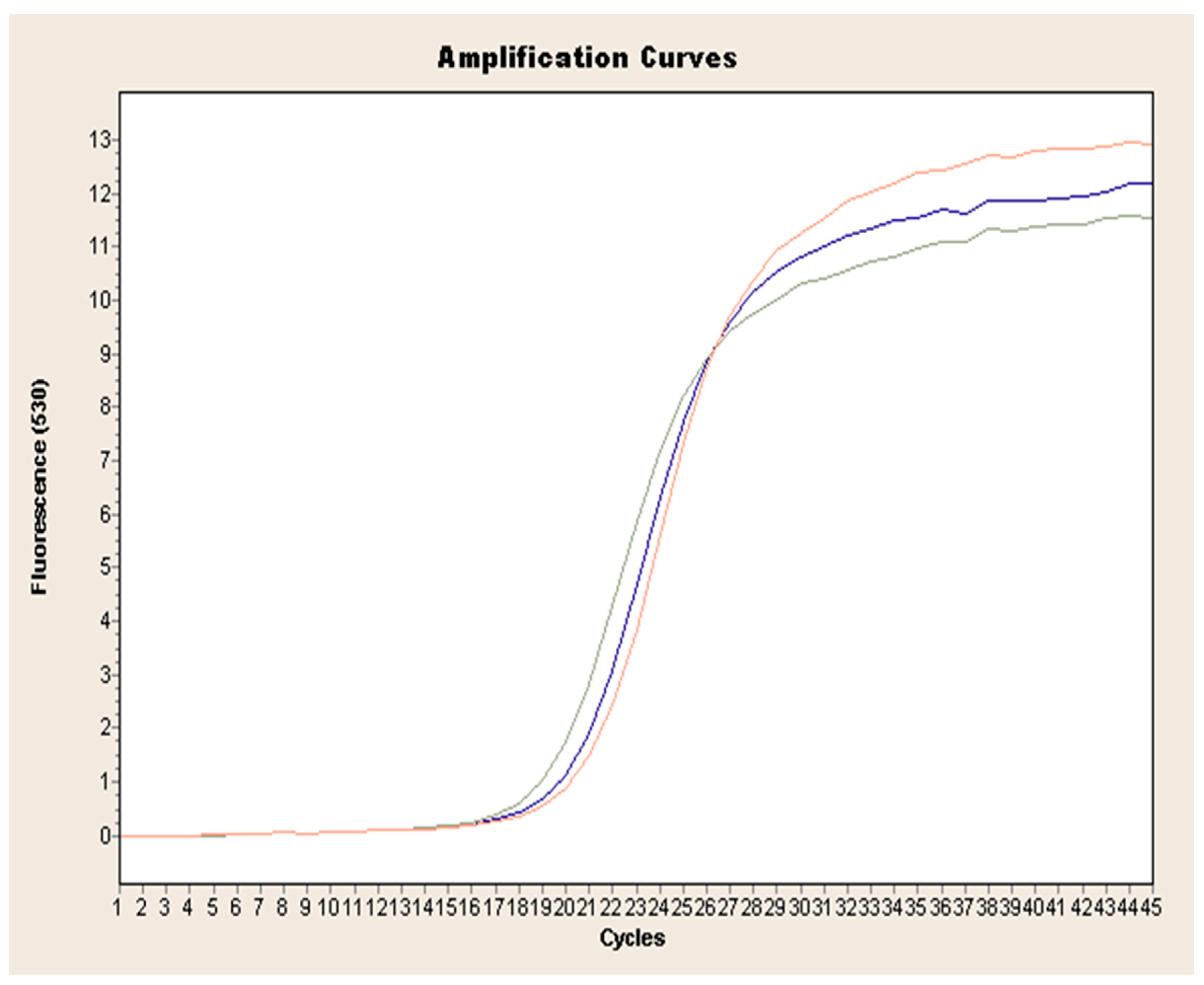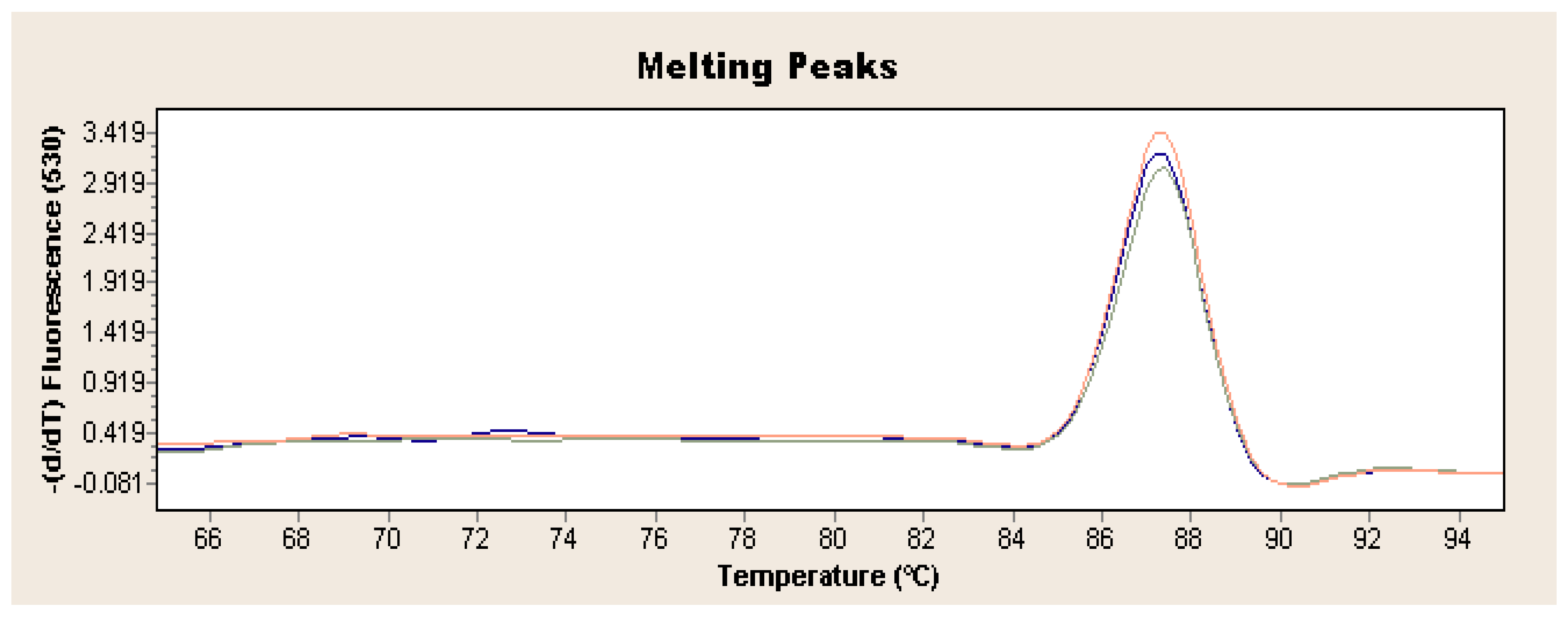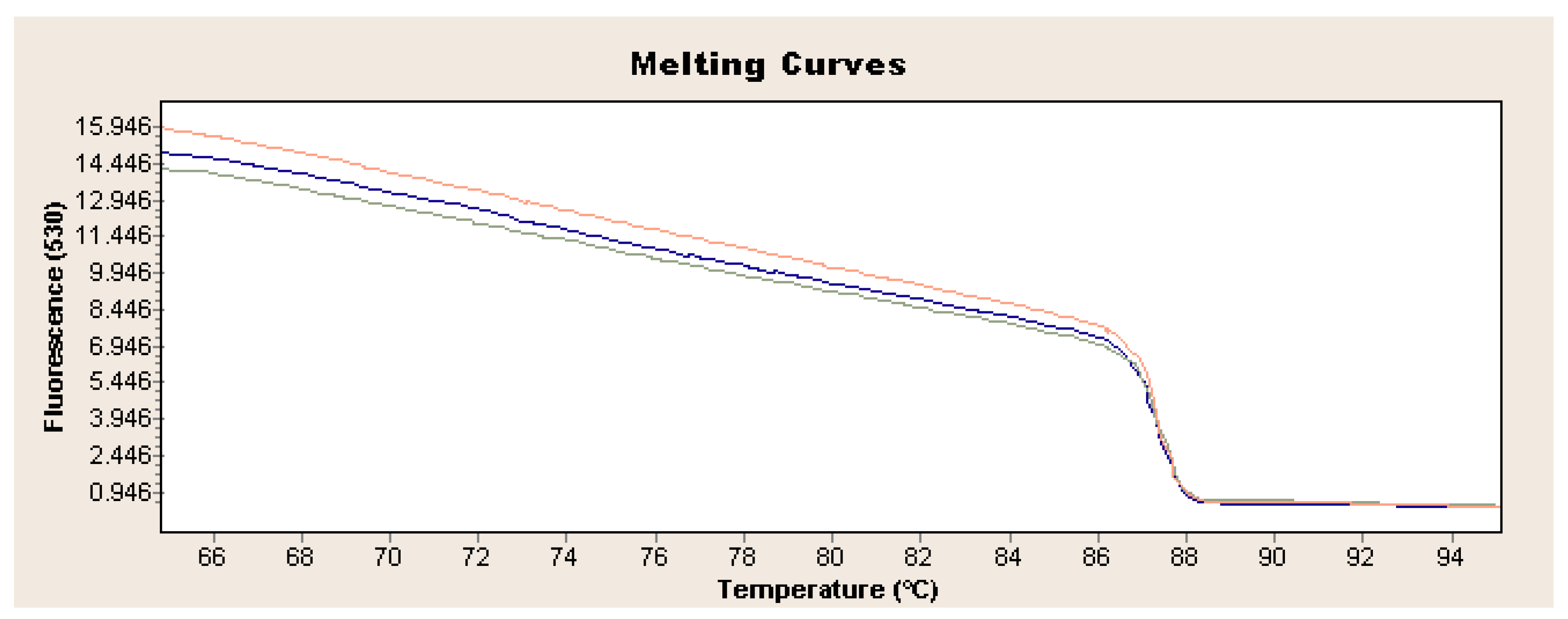Real-Time PCR Confirms Infection with Lagovirus europaeus
Abstract
Featured Application
Abstract
1. Introduction
2. Real-Time PCR in Lagovirus europaeus GI.1 and GI.2 Studies
3. Materials and Methods
3.1. Experiment
3.2. Isolation of Viral RNA
3.3. Reverse Transcription (RT) Reaction—cDNA Synthesis
3.4. Real-Time PCR
4. Results
5. Discussion
6. Conclusions
Author Contributions
Funding
Institutional Review Board Statement
Informed Consent Statement
Data Availability Statement
Conflicts of Interest
References
- Abrantes, J.; van der Loo, W.; Le Pendu, J.; Esteves, P.J. Rabbit haemorrhagic disease (RHD) and rabbit haemorrhagic disease virus (RHDV): A review. Vet. Res. 2012, 10, 12. [Google Scholar] [CrossRef] [PubMed]
- Bębnowska, D.; Niedźwiedzka-Rystwej, P. Characteristics of a new variant of rabbit haemorrhagic disease virus—RHDV2. Acta Biol. 2019, 15, 83–97. [Google Scholar] [CrossRef]
- Abrantes, J.; Lopes, A.M.; Dalton, K.P.; Parra, F.F.; Esteves, P.J. Detection of RHDVa on the Iberian Peninsula: Isolation on an RHDVa strain from a Spanisch rabbitry. Arch. Virol. 2014, 159, 321–326. [Google Scholar] [CrossRef] [PubMed]
- Niedźwiedzka-Rystwej, P.; Hukowska-Szematowicz, B.; Działo, J.; Tokarz-Deptuła, B.; Deptuła, W. Real time PCR detection of rabbit haemorrhagic disease virus in r abbits infected with different Euripean strains of RHDV. Pol. J. Vet. Sci. 2013, 16, 39–43. [Google Scholar] [CrossRef]
- International Committee on Taxonomy of Viruses (ICTV). Available online: https://talk.ictvonline.org/ictv-reports/ictv_online_report/positive-sense-rnaviruses/w/caliciviridae/1163/genus-lagovirus/ (accessed on 22 July 2020).
- Le Pendu, J.; Abrantes, J.; Bertagnoli, S.; Guitton, J.S.; Le Gall-Reculé, G.; Lopes, A.M.; Marchandeau, S.; Alda, F.; Almeida, T.; Célio, A.P.; et al. Proposal for a unified classification system and nomenclature of lagoviruses. J. Gen. Virol. 2017, 98, 1658–1666. [Google Scholar] [CrossRef]
- Liu, S.J.; Xue, H.P.; Pu, B.Q.; Quian, N.H. A new viral disease in rabbits. Anim. Hus. Vet. Med. 1984, 16, 253–255. [Google Scholar]
- Capucci, L.; Fallacara, F.; Grazioli, S.; Lavazza, A.; Pacciarini, M.L.; Brocchi, E. A further step in the evolution of rabbit hemorrhagic disease virus: The appearance of the first consistent antigenic variant. Virus Res. 1998, 58, 115–126. [Google Scholar] [CrossRef]
- Oem, J.K.; Lee, K.N.; Roh, I.S.; Lee, K.K.; Kim, S.H.; Kim, H.R.; Park, C.K.; Joo, Y.S. Identification and Characterization of Rabbit Hemorrhagic Disease Virus Genetic Variants Isolated in Korea. J. Vet. Med. Sci. 2009, 71, 1519–1523. [Google Scholar] [CrossRef]
- Le Gall-Recule, G.; Zwingelstein, F. Detection of a new variant of rabbit haemorrhagic disease virus in France. Vet. Rec. 2011, 168, 137–138. [Google Scholar] [CrossRef]
- Burmakina, G.; Malogolovkina, N.; Lunitsin, A.; Titov, I.; Tsybanov, S.; Malogolovkin, A. Comparative analysis of rabbit haemorrhagic disease virus strains originating from outbreaks in the Russian Federation. Arch. Virol. 2016, 16, 1973–1979. [Google Scholar] [CrossRef]
- Song, Y.; Wang, F.; Fan, Z.; Hu, B.; Liu, X.; Wei, H.; Xue, J.; Xu, W.; Qiu, R. Identification of novel rabbit hemorrhagic disease virus B-cell epitopes and their interaction with host histo-blood group antigens. J. Gen. Virol. 2016, 97, 356–365. [Google Scholar] [CrossRef] [PubMed]
- Gall, A.; Hoffmann, B.; Teifke, J.P.; Lange, B.; Schirrmeier, H. Persistence of viral RNA in rabbits which overcome an experimental RHDV infection detected by a highly sensitive multiplex real-time RT-PCR. Vet. Microbiol. 2007, 120, 17–32. [Google Scholar] [CrossRef] [PubMed]
- Nyström, K.; Le Gall-Reculé, G.; Grassi, P.; Abrantes, J.; Ruvoën-Clouet, N.; Le Moullac-Vaidye, B.; Lopes, A.M.; Esteves, P.J.; Strive, T.; Marchandeau, S.; et al. Histo-blood group antigens act as attachment factors of rabbit hemorrhagic disease virus infection in a virus strain-dependent manner. PLoS Pathog. 2011, 7, e1002188. [Google Scholar] [CrossRef] [PubMed]
- Liu, W.; Dand, R.; Wang, X. Development of a SYBR-based real-time PCR to detect rabbit hemorrhagic disease virus (RHDV) and analyze its tissue distribution in experimentally infected rabbits. Virol. Sin. 2015, 30, 228–230. [Google Scholar] [CrossRef] [PubMed]
- Hall, R.N.; Mahar, J.E.; Read, A.J.; Mourant, R.; Piper, M.; Huang, N.; Strive, T. A strain-specific multiplex RT-PCR for Australian rabbit haemorrhagic disease viruses uncovers a new recombinant virus variant in rabbits and hares. Transbound. Emerg. Dis. 2018, 65, e444–e456. [Google Scholar] [CrossRef] [PubMed]
- Duarte, M.D.; Carvalho, C.L.; Barros, S.C.; Henriques, A.M.; Ramos, F.; Fagulha, T.; Luis, T.; Duarte, E.L.; Fevereiro, M. A real time Taqman RT-PCR for the detection of rabbit hemorrhagic disease virus 2 (RHDV2). J. Virol. Methods 2015, 219, 90–95. [Google Scholar] [CrossRef]
- Neimanis, A.S.; Ahola, H.; Zohari, S.; Larsson Pettersson, U.; Bröjer, C.; Capucci, L.; Gavier-Widén, D. Arrival of rabbit haemorrhagic disease virus 2 to northern Europe: Emergence and outbreaks in wild and domestic rabbits (Oryctolagus cuniculus) in Sweden. Transbound. Emerg. Dis. 2018, 65, 213–220. [Google Scholar] [CrossRef]
- Calvete, C.; Mendoza, M.; Sarto, M.P.; Bagues, M.P.J.; Lujan, L.; Molin, J.; Calvo, A.J.; Monroy, F.; Calvo, J.H. Detection of Rabbit Hemorrhagic Disease Virus GI.2/RHDV2/b in the Mediterranean Pine Vole (Microtus duodecimcostatus) and White-Toothed Shrew (Crocidura russula). J. Wildl. Dis. 2019, 55, 467–472. [Google Scholar] [CrossRef]
- Niedźwiedzka-Rystwej, P.; Tokarz-Deptuła, B.; Hukowska-Szematowicz, B.; Działo, J.; Deptuła, W. Indices of non-specific immunity—An element of natural immunity in rabbits infected with RHD (rabbit haemorrhagic disease) virus. Centr. Eur. J. Immunol. 2013, 38, 232–236. [Google Scholar] [CrossRef]
- Niedźwiedzka-Rystwej, P.; Tokarz-Deptuła, B.; Hukowska-Szematowicz, B.; Działo, J.; Trzeciak-Ryczek, A.; Deptuła, W. Peripheral blood lymphocytes B and T and their subpopulations in rabbit infected with rabbit haemorrhagic disease virus (RHDV). Med. Wet. 2013, 59, 484–487. [Google Scholar]
- Niedźwiedzka-Rystwej, P.; Hukowska-Szematowicz, B.; Tokarz-Deptuła, B.; Trzeciak-Ryczek, A.; Działo, J.; Deptuła, W. Apoptosis of peripheral blood leucocytes in rabbits infected with different strains of rabbit haemorrhagic disease virus. Acta Biochem. Pol. 2013, 60, 65–69. [Google Scholar] [CrossRef]
- Niedźwiedzka-Rystwej, P.; Deptuła, W. Lymphocyte subpopulations and apoptosis of immune cells in rabbits experimentally infected with a strain of the RHD virus having a variable haemagglutination capacity. Pol. J. Vet. Sci. 2012, 15, 43–49. [Google Scholar] [CrossRef] [PubMed]
- Adamiak, M.; Niedźwiedzka-Rystwej, P.; Tokarz-Deptuła, B. Presence of the RHD (Rabbit haemorrhagic disease) virus in liver cells of rabbits determined by real-time PCR method. PhD Int. J. 2013, 1, 9–12. [Google Scholar]
- Kwit, E.; Rzeżutka, A. Molecular methods in detection and epidemiologic studies of rabbit and hare viruses: A review. J. Vet. Diagn. Invest. 2019, 31, 497–505. [Google Scholar] [CrossRef]
- Vende, P.; Le Gall, G.; Rasschaert, D. An alternative method for direct sequencing of PCR products for epidemiological studies performer by nucleic sequence comparison. Application of rabbit haemorrhagic disease virus. Vet. Res. 1997, 26, 174–179. [Google Scholar]
- Strive, T.; Wright, J.; Kovaliski, J.; Botti, G.; Capucci, L. The non-pathogenic Australian lagovirus RCV-A1 causes a prolonged infection and elicits partial cross-protection to rabbit haemorrhagic disease virus. Virology 2010, 398, 125–134. [Google Scholar] [CrossRef]
- Matthaei, M.; Kerr, P.J.; Read, A.J.; Hick, P.; Haboury, S.; Wright, J.D.; Strive, T. Comparative quantitative monitoring of rabbit haemorrhagic disease viruses in rabbit kittens. Virol. J. 2014, 11, 109. [Google Scholar] [CrossRef]
- Elsworth, P.; Cooke, B.D.; Kovaliski, J.; Sinclair, R.; Holmes, E.C.; Strive, T. Increased virulence of rabbit haemorrhagic disease virus associated with genetic resistance in wild Australian rabbits (Oryctolagus cuniculus). Virology 2014, 464–465, 415–423. [Google Scholar] [CrossRef]
- Mahar, J.E.; Read, A.J.; Gu, X.; Urakova, N.; Mourant, R.; Piper, M.; Habaury, S.; Holmes, E.C.; Strive, T.; Hall, R.N. Detection and Circulation of a Novel Rabbit Hemorrhagic Disease Virus in Australia. Emerg. Infect. Dis. 2018, 24, 22–31. [Google Scholar] [CrossRef]
- Carvalho, C.L.; Duarte, E.L.; Monteiro, M.; Botelho, A.; Albuquerque, T.; Fevereiro, M.; Henriques, A.M.; Barros, S.S.; Duarte, M.D. Challenges in the rabbit haemorrhagic disease 2 (RHDV2) molecular diagnosis of vaccinated rabbits. Vet. Microbiol. 2017, 198, 43–50. [Google Scholar] [CrossRef]
- Dalton, K.P.; Arnal, J.L.; Benito, A.A.; Chacon, G.; Martin Alonso, J.M.; Parra, F. Conventional and real time RT-PCR assays for the detection and differentiation of variant rabbit hemorrhagic disease virus (RHDVb) and its recombinants. J. Virol. Methods 2018, 251, 118–122. [Google Scholar] [CrossRef] [PubMed]
- Neimanis, A.S.; Ahola, H.; Larsson Pettersson, U.; Lopes, A.M.; Abrantes, J.; Zohari, S.; Estaves, P.J.; Gavier-Widen, D. Overcoming species barriers: An outbreak of Lagovirus europaeus GI.2/RHDV2 in an isolated population of mountain hares (Lepus timidus). BMC Vet. Res. 2018, 14, 367. [Google Scholar] [CrossRef]
- Camacho-Sillero, L.; Caballero-Gomez, J.; Gomez-Guillamon, F.; Martinez-Padilla, A.; Aguero, M.; San Miquel, E.; Zorrilla, I.; Rayas, E.; Talavera, V.; Garcia- Bocanegra, I. Monitoring of the novel rabbit haemorrhagic disease virus type 2 GI2 epidemic in European wild rabbits (Oryctolagus cuniculus) in southern Spain, 2013–2017. Veter. Micriobiol. 2019, 237, 108361. [Google Scholar] [CrossRef] [PubMed]
- Naeve, M.J.; Hall, R.N.; Huang, N.; McColl, K.A.; Kerr, P.; Hoehn, M.; Strive, T. Robust Innate Immunity of Young Rabbits Mediates Resistance to Rabbit Hemorrhagic Disease Caused by Lagovirus Europaeus GI.1 But Not GI.2. Viruses 2018, 10, E512. [Google Scholar] [CrossRef]
- Hanan, A.F.; Arafa, A.; Mahamoud, A.H. Molecular diagnosis of rabbit hemorrhagic disease virus (RHDV). Egypt J. Comp. Path Clinic. Path. 2010, 23, 85–101. [Google Scholar]
- Fitzner, A.; Niedbalski, W.; Kęsy, A.; Paprocka, G. Detection of RHD virus by Real-time Reverse Transcription PCR. Bull. Vet. Inst. Pulawy 2011, 55, 581–586. [Google Scholar]
- Beneviedes, S.; Toste, S.; Bernando, S.A.; Flor, L. Optimization of a real time PCR for the detection of rabbit haemorrhagic disease virus in infected rabbits from Azores. RPCV 2015, 110, 593–594. [Google Scholar]
- Duarte, M.; Carvalho, C.; Bernardo, S.; Barros, S.V.; Benevides, S.; Flor, L.; Monteiro, M.; Marques, I.; Henriques, M.; Barros, S.C.; et al. Rabbit haemorrhagic disease virus 2 (RHDV2) outbreak in Azores: Disclosure of common genetic markers and phylogenetic segregation within the European strains. Infect. Genet. Evol. 2015, 35, 163–171. [Google Scholar] [CrossRef]
- Klein, D. Quantification using real-time PCR technology: Applications and limitations. Trends Mol. Med. 2002, 8, 257–260. [Google Scholar] [CrossRef]
- Jayamohan, H.; Lambert, C.J.; Sant, H.J.; Jafek, A.; Patel, D.; Feng, H.; Beeman, M.; Mahmood, T.; Nze, U.; Gale, B.K. SARS-CoV-2 pandemic: A review of molecular diagnostic tools including sample collection and commercial response with associated advantages and limitations. Anal. Bioanal. Chem. 2020, 1–23. [Google Scholar] [CrossRef]




| Strain | Sample Number | Result | Tm (°C) | Ct |
|---|---|---|---|---|
| 237/04 | 1 | + | 87.51 | 24.57 |
| 2 | + | 87.52 | 19.78 | |
| 3 | + | 87.55 | 19.95 | |
| 4 | + | 87.56 | 18.05 | |
| 5 | + | 87.60 | 18.78 | |
| 6 | + | 87.59 | 19.00 | |
| 72V/2003 | 1 | + | 87.32 | 19.04 |
| 2 | + | 87.42 | 18.06 | |
| 3 | + | 87.38 | 19.71 | |
| 4 | + | 87.63 | 16.68 | |
| 5 | + | 87.47 | 17.59 | |
| 6 | + | 87.38 | 17.74 | |
| Hartmannsdorf | 1 | + | 87.35 | 22.54 |
| 2 | + | 87.54 | 19.85 | |
| 3 | + | 87.63 | 21.38 | |
| 4 | + | 87.48 | 18.27 | |
| 5 | + | 87.43 | 18.63 | |
| 6 | + | 87.72 | 19.52 |
| Primer | Genogroup | Reference |
|---|---|---|
| vp60-7_for—ACYTGACTGAACTYATTGACG vp60-8_rev—TCAGACATAAGAAAAGCCATT GG | GI.1 | [13] |
| RHDV-P33(F)—CCACCACCAACACTTCAGGT RHDV-P34(R)—CAGGTTGAACACGAGTGTGC | [26] | |
| RHDV-RT2-fw—ACCCAGTACGGCACRGGCTCCCAACCAC RHDV-RT2-rv—CTATCTCCATGAAACCAGATGCAAAGG | [27] | |
| forward primer—TCTGTCGTCAGGCGCACC reverse primer—GACGAGTAGTTGTTGAGCGAAAG | [14] | |
| forward primer—ACYTGACTGAACTYATTGACG reverse primer—TCAGACATAAGAAAAGCCATTGG | [4] | |
| forward primer—ACCCAGTACGGCACRGGCTCCCAACCAC revers primer—CTATCTCCATGAAACCAGATGCAAAGG | [28] | |
| forward primer—GTTGTATTCGGGCAACCGGAAG revers primer—CTATGGAACACAAGCAAACATCACCA | ||
| forward primer—GGTTGTTTATGGTGCCTGTAA revers primer—GCACAAATTACCTTGTCCCAAAAGTTT | ||
| forward primer—ACCCAGTACGGCACRGGCTCCCAACCAC reverse primer—CTATCTCCATGAAACCAGATGCAAAGG | [29] | |
| VP60-D-Is—GTTCCCACACTGGTCCTTAG VP60-D-Ia—GTGAGGACTGGGGTCGTGAG | [15] | |
| GI_qRTPCR_Fw—TTGACRTACGCCCTGTGGGACC GI_qRTPCR_Rv—TCAGACATAAGARAAGCCATTRGYTG | [16] | |
| GI.1a-Aus_fwd—GCGTGGCATTGTGCGCAGCATCGI.1a-Aus_rev—TGTTGGTGATAAGCCATAATCGCG | ||
| GI.1c_fwd—AGCAAGACTGTTGACTCAATTTCG GI.1c_rev—AGGCCTGCACAGTCGTAACGTT | ||
| GI.1a-K5_fwd—TTTATAGATGTATGCCCGCTCAAC GI.1a-K5_rev—CCGTTCGAGTTCCTTGCGGACG | ||
| RHDVXa2010-F1—GCACCCGGCAGTATTCTC RHDVXa2010-R1—CCCAGCCAGCGTACATCTG | [30] | |
| RHDV2-F—TGGAACTTGGCTTGAGTGTTGA RHDV2-R—ACAAGCGTGCTTGTGGACGG | GI.2 | [17] |
| RHDV2.F1—GTCGTCTCGGTAGTACCTG RHDV2.R1—GTTGCCTGTCGGGTGGTAC | [18] | |
| RHDV2.F2—ACAATTCCCTCATGTTGTCATTG RHDV2.R2—GGGTTGTCAGCTGCAGACC | ||
| RHDV2.3F—GCGGTTTGCCGCCATTGAC RHDV2.3R—GTTAGCTGAACCGGCCTCAG | ||
| RHDV2.4F—CAGCCAAACAGGATTGTCAATG RHDV2.4R—CCTGCAAGTCCCAATCCAAC | ||
| 27F—CCATGCCAGACTTGCGTCCC 986R—AACCATCTGGAGCAATTTGGG | [31] | |
| 717F—CGCAGATCTCCTCACAACCC RC10R—GCGCCTGCAAGTCCCAATCC | ||
| RHDVbf—GACCACGACAGAGGTAACGC RHDVbr—TGTCAGCTGCAGACCCG | [32] | |
| RHDV2.F1—GTCGTCTCGGTAGTACCTG RHDV2.R1—GTTGCCTGTCGGGTGGTAC | [33] | |
| RHDV2.F2—ACAATTCCCTCATGTTGTCATTG RHDV2.R2—GGGTTGTCAGCTGCAGACC | ||
| RHDV2.3F—GCGGTTTGCCGCCATTGAC RHDV2.3R—GTTAGCTGAACCGGCCTCAG | ||
| RHDV2.4F—CAGCCAAACAGGATTGTCAATG RHDV2.4R—CCTGCAAGTCCCAATCCAAC | ||
| forward primer—TCCAGATGGTTTYCCTGACATG reverse primer—GCGGTAGGGARGGTGYTG | [34] | |
| GI_qRTPCR_Fw—TTGACRTACGCCCTGTGGGACC GI_qRTPCR_Rv—TCAGACATAAGARAAGCCATTRGYTG | GI.1 and GI.2 | [35] |
Publisher’s Note: MDPI stays neutral with regard to jurisdictional claims in published maps and institutional affiliations. |
© 2021 by the authors. Licensee MDPI, Basel, Switzerland. This article is an open access article distributed under the terms and conditions of the Creative Commons Attribution (CC BY) license (http://creativecommons.org/licenses/by/4.0/).
Share and Cite
Bębnowska, D.; Hrynkiewicz, R.; Niedźwiedzka-Rystwej, P. Real-Time PCR Confirms Infection with Lagovirus europaeus. Appl. Sci. 2021, 11, 656. https://doi.org/10.3390/app11020656
Bębnowska D, Hrynkiewicz R, Niedźwiedzka-Rystwej P. Real-Time PCR Confirms Infection with Lagovirus europaeus. Applied Sciences. 2021; 11(2):656. https://doi.org/10.3390/app11020656
Chicago/Turabian StyleBębnowska, Dominika, Rafał Hrynkiewicz, and Paulina Niedźwiedzka-Rystwej. 2021. "Real-Time PCR Confirms Infection with Lagovirus europaeus" Applied Sciences 11, no. 2: 656. https://doi.org/10.3390/app11020656
APA StyleBębnowska, D., Hrynkiewicz, R., & Niedźwiedzka-Rystwej, P. (2021). Real-Time PCR Confirms Infection with Lagovirus europaeus. Applied Sciences, 11(2), 656. https://doi.org/10.3390/app11020656







